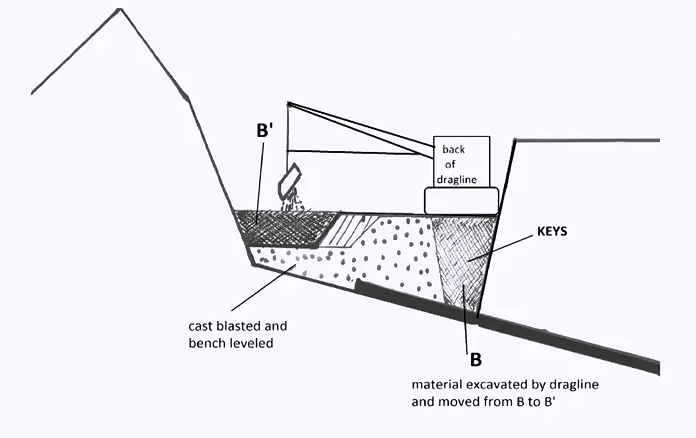Everything about Excavation Companies
Wiki Article
What Does Excavating Contractors Do?
Table of ContentsA Biased View of Excavation CompaniesFascination About DemolitionConcrete Contractors for BeginnersExcavation Companies Can Be Fun For AnyoneThe 2-Minute Rule for Concrete Contractors


Scrapers or Pans excavate dirt in one area, haul and dispose the dirt in another spot (mini excavator). It is tough to match the effectiveness of scrapers for cut/fill dirt operation if the haul distance is less then a mile. Scrapers are normally drawn by a rubber tire wheel tractor as well as are sometimes pushed through the cut area by a bulldozer.
There are several times that scrapes are not made use of for site grading and a dump truck is utilized: the haul may be to long, the haul may cross roads where scrapes are not allowed, acid rock may be run into, equipment availability, etc. Discard vehicles are in common usage and probably require little discussion.
Lots of trucks have a top-hinged tailgate that can not dump any kind of rock broader after that the tailgate width. "Rock body" beds, on the various other hand, have no tailgates as well as can dispose any kind of size rock, although their quantity capacity is decreased. These web links show devices requirements for numerous usual dump trucks. Compaction Devices enhances the density of the dirt and also in some cases provides a smooth, rolled surface area.
Little Known Questions About Mini Excavator.
From a straightforward examination pit to percussion drilling to core boring the proprietor has increasingly extra expensive alternatives that produce progressively far better information regarding the site underground. For instance, the Owner on a 100,000 SF building project may authorize twenty uninteresting places with split spoon dirt examples taken till rock is gotten to and after that core examples of rock.Recognizing the type and quality of rock (from the core samples) and also place of rock (from the soils boring) is an actual benefit in jobsite preparation. Conversely, the Proprietor of a 100,000 SF building may choose to continue with no geotechnical screening whatsoever. The decision regarding geotechnical testing is normally made by an Owner without input from the Construction Supervisor.
The area on Dirts and Geology assists you recognize the terms in the geotechnical record. An understanding of the approximate location of the rock aids the Building and construction Manager to plan the sequence of actions adhering to rock excavation. If rock is in one edge of a huge building project, as an example, the planet excavation could start at the contrary end of the building in order to start structure job soonest.
Beginning the foundation job early would be a great idea if the rock might be removed by tearing. If the rock is incredibly hard and also requires substantial blasting, it might be sensible to hold structure job until the blasting is finished. The Building Manager must coordinate these sorts of choices and utilize all the technological day available.
The smart Trick of Concrete Contractors That Nobody is Talking About
Unclassified excavation states that all rock or other unforeseen materials (excluding unsafe materials) encountered in the sitework will certainly be the responsibility of the Contractor at no learn the facts here now modification in agreement expense. An unclassified excavation is simpler from a book-keeping perspective and places the responsibility for geotechnical conditions onto the Sitework Contractor.Just How Water Influences Sitework? It's impressive what a heavy rainfall can do to a construction job. Prior to the rain, the website may be dry, heavy tools efficiently relocating earth, the various other trades efficiently executing their work. Within hrs the project can be a careless, mud-hole with employee effectiveness cut to regarding 10%.
In a lot of locations of the globe, the Construction Supervisor need to bear in mind a simple reality: IT WILL RAIN. Excellent planning can minimize the damages as well as disturbance of a hefty rainfall to a jobsite. Frequently the excavation and also grading is entrusted to the Sitework Contractor (and their Foremen is liable to supervise and also direct the hefty devices as well as operators).
For That Reason the Building Supervisor have to be continually mindful of what rainfall will certainly do to the job website. It is not unusual for the Sitework Foreman to function their heavy equipment for maximum effectiveness as well as wish it doesn't rain. Among the very best means to get ready for rain is to incline all qualities to drain and to smooth rolled the surface before a rain.
The 5-Minute Rule for Excavation Companies
The Building Manager have to be perceptive enough to insure that hefty rainfall does not quit working on the project longer than required. Daily discussions with Sitework Foremen may be required to attain this objective. Any type of time excavation is needed below the existing water level on a task, the process of dewatering have to be thought about.In an absolutely natural soil, the water takes a trip so gradually with the clay or silt that dewatering Go Here is not generally required for the reasonably brief time of excavation. Dewatering may be required for a solitary ground excavation or for an entire job site. One of the most usual dewatering methods are trench drains pipes, deep wells as well as well factors.

Ground water infiltration can also be lowered by cutoff techniques such as sheet loading. High dewatering prices have paled the earnings margins on far as well numerous projects.
This alternative must constantly be thought about when analyzing the prospect of dewatering. Undoubtedly the choice is just viable if gravity can run the water to lower ground. Trench drains can be reduced with a backhoe and filled with a rugged, granular product (# 4 rock for instance), however treatment should be exercised in choosing the water electrical outlet type and also location.
Indicators on Excavation Contractors Near Me You Should Know
A siphon, necessarily, makes use of climatic stress to carry water from one altitude, up over a barrier, to a lower altitude. The pipes in a siphon system need to be closed and some resourcefulness is frequently needed to totally load the siphon pipe. The siphon pipeline should be complete for the siphon to begin.A deep well is composed of a pump, hose pipe and a vertical well casing. The pump consumption is at the bottom of the well casing (typically some crushed stone is put there as a filter tool) (excavation contractors near me). The water is inflated the pipe, out of the well case, as well as to an appropriate discharge place.
In a rugged sand, for instance, a big location can be pumped to near the pump intake altitude. A less permeable dirt, on the other hand, minimizes the performance of a deep well. Given that the pump is typically at the bottom of the deep well, there are no elevation limitations because of vacuum lift, and deep wells can decrease the groundwater over 50 feet.
Under of the wellpoint there is a 2 foot long screen and also valve, water jets out of this shutoff as website here well as produces a hole right into which the wellpoint pipeline can be lowered. This opening is typically made a bigger size (for instance 10 inches) to allow for a crude sand backfill to assist filter the water (demolition).
Report this wiki page